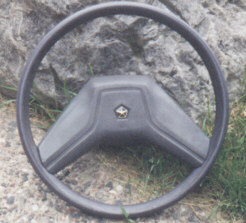The K Car
The K car came as a 6 passenger, wagon, sedan, and coupe versions.Base prices for 1982 are:
Wagon:$7,334
Sedan:$6,629
Coupe:$5,990
The standard engine was a 84 hp 2.2 litre, electronic feedback 2bbl carb,hemi heads,pared with either a 4-spd manual, or a 3-spd auto.The optional engine was a 2.6 liter w/hemi heads and balance shafts.The output was 101 hp.The look was boxy, until the 1985 "face lift" of the grill, hood, and tailights.The millage for a '82 Aries Coupe/Sedan is 41 highway/26 city.On the wagon, its 40/26.In 1985, the 2.6 was dropped in favor of a Chrysler 2.5 w/TBI and balance shafts.The 2.2 gained TBI.The 2.5 is a 2.2 with a longer stroke and balance shafts.Gauges were minimal, temp gauge, votometer, and gas gauge(But no oil gauge!).Idiot lights are as follows:belts,brake,high beam,oil, and check engine.The turn signals were labled "left" and "right".Their run ended in 1989.They were replaced by the AA body Spirit/Acclaim.Part of their end was that they didnt come with the Mitsu 3.0 V6.By 89, they were equpped with, nice digital radios, except for the fact that they were a little under-powered,K's were a well rounend car.Performance times and Drivetrains are here.Production figures are here. Note: the minivans were based on the K platform (first generation).
The Ks bowed for 1981 as the Dodge Aries and Plymouth Reliant. A 2 door coupe, 4 door sedan, and 5 door wagon were available. Base power was a 2.2 (135 cid) in-line-four fed by a 2 barrel electronic feedback carburetor with a progressive opening (like 4-barrels of yore, opening first the primary bore and then, as the pedal was depressed further, the secondary bore) and fired by a distributor with electronic ignition. The motor churned out 82 hp. Transaxles were a 4-speed floorshift manual or a 3-speed automatic. The car did 0-60 in the 13 second range. A 2.6 Mitsubishi motor was optional, and cars bearing this motor - for 1981 at least - were adorned with the badge "2.6 HEMI." (Yes, they were hemi-heads!) Note, the 2.2 came with hemi heads.
1981 cars had no roll-down rear windows! They weighed about 2300 - 2400 lb, and cost $5,880 for the base model.
Early sales of the K were poor, due to some bad planning on Chrysler?s part. Ads touted the K?s low price,$5,990, but Chrysler was building cars with options like automatic transmissions, A/C, nice wheels, etc. People flocked to the showroom but did not buy; they expected the price they had seen advertised, and found cars costing hundreds or thousands more. Chrysler quickly realized their mistake and started building bare-bones Aries and Reliants, and sales took off.
1982 brought a linkless antisway bar to the front suspension, a counterbalanced hood, and a reworked manifold and quieter fan for the 2.2.
By 1983, Chrysler had paid its debts. The Reliant had earned its keep and then some. As if to celebrate, the 2.2 gained a power boost to 94 hp (9:1 compression ratio), and a five speed manual transmission was offered. Power brakes became standard.
The Ks were mostly unchanged until 1984, when they received a new black dashboard with round gauges. Although it was a simple version (the turn signal arrows were actually labeled "left" and "right"), Chrysler would use this readable dash pattern in many cars through the 90s.
1984 also brought the 2.6 liter engine up to 101 hp (and the 2.2 up to 96 hp, its highest non-turbo power), a slight suspension reworking, a new electronic radio, and a 14 gallon gas tank.
In 1985, the K received a pleasant facelift, with a rounded front fascia (the blacked-out version on the Aries is rather pretty), smoother hood, and bigger taillights. Also added was a new climate control panel, map pockets, and an available heavy duty suspension.
1986 saw the end of the 2.6 liter engine and the addition of fuel injection on the 2.2, bringing it to its final horsepower (maintained through 1994) of 93 hp. The five speed manual became standardd, and a 2.5 liter engine was standard. This 2.5 had single-point fuel injection, 96 hp, and a long stroke for lower emissions and better low-end power. Its balance shafts made it smoother and quieter, though they hurt the high end.
1987 brought a stainless steel exhaust.
In 1988, after success with the Omni and Horizon America, the K went on the America plan; many options were made standard, and the option list was narrowed. This made the cars cheaper to build, and prices were slashed - the Aries America started at $6995. It worked; sales of the aging K-car continued to be strong. The transmission was also enhanced (with the 2.2) by a Chrysler invention, the lockup torque converter.
1989 was the Reliant/Aries' final year. As if to celebrate, the 2.5 went up to 100 hp, the most power it would ever produce without a turbo, and a four speaker stereo was made optional. By this time, the K had become a rather pleasant car to drive; LE models had plush cloth interiors, good sound insulation, nice digital radios, and, frequently, the 2.5/auto combination. They were quiet, plush and smooth-running, compared to the early models. And the prices were still rather cheap. As seemed to be Chrysler?s tradition, the Ks, for their final year, were allowed to share the showroom floor with their replacement model - in this case, the larger A-body Spirit. The Spirit would offer features new to the K-car, such as stiffer steering (first seen in the "Euro-style? Lancer and LeBaron GTS, and Shadow
